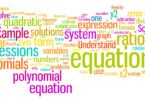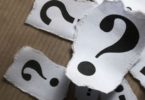Sets, Relations and Functions (Maths) Quiz:
Out of 800 boys in a school, 224 played cricket, 240 played hockey and 336 played basketball. Of the total, 64 played both basketball and hockey; 80 played cricket and basketball and 40 played cricket and hockey; 24 played all the three games. The number of boys who did not play any game is
(a) 128
(b) 216
(c) 240
(d) 160
Let L be the set of all straight lines in the Euclidean plane. Two lines l1 and l2 are said to be related by the relation R i is parallel to l2. Then the relation R is
(a) Reflexive
(b) Reflexive and Symmetric
(c) Transitive and Equivalence
(d) all
Let A = {a, b, c} and B = {1, 2}. Consider a relation R defined from set A to set B. Then R is equal to set
(a) A
(b) B
(c) A x B
(d) B x A
A relation R on a non-empty set A is an equivalence relation if and only if it is
(a) Reflexive
(b) Symmetric and transitive
(c) Reflexive, symmetric and transitive
If A = {1, 2, 3, 4, 5}, then the number of proper subsets of A is
(a) 120
(b) 30
(c) 31
(d) 32
Related: Trigonometry Ratios Sample Paper
Let S be the set of all real numbers. Then the relation R = {(a, b) : 1 + ab > 0} on S is
(a) Reflexive and symmetric but not transitive
(b) Reflexive and transitive but not symmetric
(c) Symmetric, transitive but not reflexive
(d) Reflexive, transitive and symmetric
Let A and B be two non-empty subsets of a set X such that A is not a subset of B, then
(a) A is always a subset of the complement of B
(b) B is always a subset of A
(c) A and B are always disjoint
(d) A and the complement of B are always non-disjoint
x2 = xy is a relation which is
(a) Symmetric
(b) Reflexive
(c) Transitive
Let A = {1, 2, 3, 4, 5, 6}, which of the following partitions of A correspond to an equivalence relation on A?
(a) [{1, 2, 3},{3, 4, 5, 6}]
(b) [{1, 2},{4, 5, 6}]
(c) [{1, 2},{3, 4},{2, 3, 5, 6}]
(d) [{1, 3},{2, 4, 5},{6}]
Let R be an equivalence relation on a finite set A having n elements. Then the number of ordered pairs in R is
(a) Less than n
(b) Less than or equal to n
(c) Greater than or equal to n
Related: organic chemistry Nomenclature practice with answers
In a certain town, 25% of families own a phone and 15% own a car, 65% of families own neither a phone nor a car. 2000 families own both a car and a phone. Consider the following statements in this regard:
(1) 10% of families own both a car and a phone
(2) 35% of families own either a car or a phone
(3) 40,000 families live in the town
Which of the above statements is correct?
(a) 1 and 2
(b) 1 and 3
(c) 2 and 3
(d) 1, 2 and 3
The relation “is subset of” on the power set P(A) of a set A is
(a) Symmetric
(b) Anti-symmetric
(c) Equivalency relation
Two finite sets have m and n elements. The total number of subsets of the first set is 56 more than the total number of subsets of the second set. The values of m and n are
(a) 7, 6
(b) 6, 3
(c) 5, 1
(d) 8, 7
The number of proper subsets of the set {1, 2, 3} is
(a) 8
(b) 7
(c) 6
(d) 5
Related: quiz on Minerals
In a class of 100 students, 55 students have passed in Mathematics and 67 students have passed in Physics. Then the number of students who have passed in Physics only is
(a) 22
(b) 33
(c) 10
(d) 45
If A = {1, 2, 3} , B = {1, 4, 6, 9} and R is a relation from A to B defined by ‘x is greater than y’. The range of R is
(a) {1, 4, 6, 9}
(b) {4, 6, 9}
(c) {1}
Let A = {1, 2, 3}, which of the following is not an equivalence relation on A?
(a) [{(1, 1), (2, 2), (3, 3)}]
(b) [{(1, 1), (2, 2), (3, 3), (1, 2), (2, 1)}]
(c) [{(1, 1), (2, 2), (3, 3), (2, 3), (3, 2)}]
(d) [{(1, 2), (2, 3)}]
The relation R = {(1, 1), (2, 2), (3, 3), (1, 2), (2, 3), (1, 3)} on set A = {1, 2, 3} is
(a) Reflexive but not symmetric
(b) Reflexive but not transitive
(c) Symmetric and Transitive
(d) Neither symmetric nor transitive
Given the relation R = {(1, 2), (2, 3)} on the set A = {1, 2, 3}, the minimum number of ordered pairs which when added to R make it an equivalence relation is
(a) 5
(b) 6
(c) 7
(d) 8
Related: the resistivity of the conductor depends on mcq
The relation R defined on the set of natural numbers as {(a, b) : a differs from b by 3}, is given by
(a) {(1, 4, (2, 5), (3, 6),…..}
(b) {(4, 1), (5, 2), (6, 3),…..}
(c) {(1, 3), (2, 6), (3, 9),..}
An integer m is said to be related to another integer n if m is a multiple of n. Then the relation is
(a) Reflexive and symmetric
(b) Reflexive and transitive
(c) Symmetric and transitive
(d) Equivalence relation
Let R = {(1, 3), (4, 2), (2, 4), (2, 3), (3, 1)} be a relation on A = {1, 2, 3, 4}, then R is
(a) Not symmetric
(b) Transitive
(c) A function
(d) Reflexive
Given the relation R = {(1, 2), (2, 3)} on the set A = {1, 2, 3}, the minimum number of ordered pairs which when added to R make it an equivalence relation is
(a) 5
(b) 6
(c) 7
(d) 8
Let R = {(3, 3), (6, 6), (9, 9), (12, 12), (6, 12), (3, 9), (3, 12), (3, 6)} be a relation on the set A = {3, 6, 9, 12}. The relation is
(a) An equivalence relation
(b) Reflexive and transitive only
(c) Reflexive and symmetric only
(d) Reflexive only
Related: Cell cycle quiz multiple choice
The number of non-empty subsets of the set {1, 2, 3, 4} is
(a) 15
(b) 14
(c) 16
(d) 17
Let A and B be two non-empty subsets of a set X such that A is not a subset of B, then
(a) A is always a subset of the complement of B
(b) B is always a subset of A
(c) A and B are always disjoint
(d) A and the complement of B are always non-disjoint
Let A = {1, 2, 3} and B = {2, 3, 4}, then which of the following is a function from A to B?
(a) {(1, 2), (1, 3), (2, 3), (3, 3)}
(b) {(1, 3), (2, 4)}
(c) {(1, 3), (2, 3), (3, 3)}
(d) {(1, 2), (2, 3), (3, 4), (3, 2)}
The relation “less than” in the set of natural numbers is
(a) Only symmetric
(b) Only transitive
(c) Only reflexive
(d) Equivalence relation
Two finite sets have m and n elements. The total number of subsets of the first set is 56 more than the total number of subsets of the second set. The values of m and n are
(a) 7, 6
(b) 6, 3
(c) 5, 1
(d) 8, 7
Related: structural isomers practice problems
A relation R from A to B is given by R = {(1, a), (1, b), (3, a), (3, b), (5, c)}. What is the minimum possible number of ordered pairs in A x B ?
(a) 6
(b) 3
(c) 12
(d) 9
If A = {2, 4, 5}, B = {7, 8, 9}, then n(A x B) is equal to
(a) 6
(b) 9
(c) 3
(d) 0
Let R = {(1, 3), (4, 2), (2, 4), (2, 3), (3, 1)} be a relation on the set A = {1, 2, 3, 4}. The relation R is
(a) Reflexive
(b) Transitive
(c) Not symmetric
(d) A function
Let A = {a, b, c} then the range of the relation R = {(a, b), (a, c), (b, c)} defined on A is
(a) {a, b}
(b) {c}
(c) {a, b, c}
(d) {b, c}
The domain of the function f = {(1, 3), (3, 5), (2, 6)} is
(a) {1, 2, 3}
(b) {1, 2}
(c) {3, 5, 6}
(d) {5, 6}
Related: questions on stoichiometry
Which of the following statements is not correct for the relations R defined by aRb, if and only, if b lives within on kilometer from a“
(a) R is reflexive
(b) R is symmetric
(c) R is not anti-symmetric
Let A = {1, 2, 3}. Then the domain of the relation R = {(1, 1), (2, 3), (2, 1)} defined on A is
(a) {1, 2,}
(b) {1, 3}
(c) {1, 2, 3}
(d) {1}
Let A = {1, 2, 3, 4} which of the following functions is a bijection from A to A?
(a) {(1, 2), (2, 3), (3, 4), (4, 1)}
(b) {(1, 2), (2, 2), (3, 2), (4, 2)}
(c) {(1, 2), (2, 2), (3, 3), (4, 3)}
(d) {(1, 4), (2, 3), (3, 3), (4, 2)}
Let X be a family of sets and R be a relation on X defined by ‘A is disjoint from B’. Then R is
(a) Reflexive
(b) Symmetric
(c) Anti-symmetric
(d) Transitive
Related: mcq on current electricity
Given two finite sets A and B such that n(A) = 2, n(B) = 3. Then total number of relations from A to B is
(a) 4
(b) 8
(c) 64
If for a function f(x), f(x + y) = f(x) + f(y) for all real number ‘x’ and ‘y, then f(0)= __
(a) 1
(b) -1
(c) 2
(d) 0
If R is a relation from a set A to a set B and S is a relation from B to a set C, then the relation SoR
(a) is from A to C
(b) is from C to A
(c) Does not exist
Let A = {1, 2, 3}, then the relation R = {(1, 1), (2, 2), (1, 3)} on A is
(a) Reflexive
(b) Transitive
(c) Symmetric







amazing felling here.
H?, eg vildi vita ver? ?itt.
sir this is vry helpful